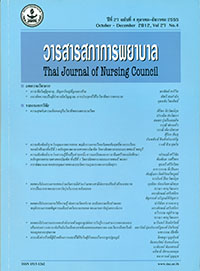ความสุขกับความคิดคงอยู่ในวิชาชีพของพยาบาลไทย
Keywords:
พยาบาลวิชาชีพไทย, ความสุข, ความคิดคงอยู่, Thai registered nurses, happiness, professional attachmentAbstract
บทคัดย่อ
การศึกษาเรื่องนี้มีวัตถุประสงค์เพื่ออธิบายระดับความสุขของพยาบาลวิชาชีพใน ประเทศไทย และระบุปัจจัยที่เกี่ยวข้องกับความสุขและความคิดคงอยู่ในวิชาชีพตามการรับรู้ของ พยาบาลวิชาชีพ วิธีการวิจัยใช้แบบผสานโดยการใช้วิธีการวิจัยเชิงปริมาณร่วมกับเชิงคุณภาพ ดำเนิน การเก็บข้อมูลในระหว่างเดือนพฤษภาคม-ตุลาคม 2554 ในส่วนการวิจัยเชิงปริมาณ กลุ่มตัวอย่างได้ มาจากการสุ่มแบบกลุ่ม (Cluster sampling) เก็บข้อมูลจากแบบสอบถามมาตรฐาน Thai Happiness Indicators 15 ได้รับแบบสอบถามกลับจำนวน 3,219 ชุด วิเคราะห์ข้อมูลโดยใช้การแจกแจงความถี่ ร้อยละ และ 95% เชื่อมั่น Odds Ratio และ Logistic Regression ส่วนการวิจัยเชิงคุณภาพ ผู้ให้ข้อมูล หลักเป็นพยาบาลวิชาชีพที่เลือกมาอย่างเฉพาะเจาะจง ในจังหวัดเชียงใหม่ขอนแก่น ชลบุรี กรุงเทพ และสงขลา เก็บข้อมูลโดยการสนทนากลุ่มและการสัมภาษณ์ผู้ให้ข้อมูลหลักจนข้อมูลอิ่มตัวที่จำนวน 518 คน วิเคราะห์ข้อมูลด้วยวิธีการวิเคราะห์เนื้อหา และวิเคราะห์แก่นสาระ
ข้อค้นพบของส่วนการวิจัยเชิงคุณภาพ พบว่า ความสุขเกิดจากใจรักในวิชาชีพ และการช่วย ผู้ป่วย และประชาชนเสมือนว่า “ได้ทำบุญทุกวันจากการให้การพยาบาล” และอุดมการณ์นี้เองที่หล่อเลี้ยงจิตวิญญาณาของพยาบาลให้เข้มแข็ง สามารถคงอยู่ในวิชาชีพนี้ได้แม้ว่าส่วนใหญ่ไม่มีความสุขในการทำงาน
ผลการสำรวจพบว่าร้อยละ 65 ของพยาบาลมีค่าคะแนนความสุขในระดับต่ำกว่าคนทั่วไปมีปัจจัย 7 ด้าน ที่มีความสัมพันธ์กับความสุข และความคิดคงอยู่ในวิชาชีพอย่างมีนัยสำคัญทางสถิติที่ .05 คือ ด้านความปลอดภัย ความรุนแรง สวัสดิการ ความก้าวหน้า อำนวจต่อรอง การยอมรับ และบรรยากาศในการทำงาน ผลการวิจัยดังกล่าวชี้นำว่าการแก้ไขปัญหาการขาดแคลนพยาบาลในประเด็นของการเพิ่มความสุขและการสร้างเสริมการคงอยู่ในวิชาชีพของพยาบาลวิชาชีพนั้นจะต้องดำเนินการทั้งในระดับโครงสร้างองค์ก และในระดับปฏิบัติการ
คำสำคัญ : พยาบาลวิชาชีพไทย, ความสุข, ความคิดคงอยู่
Abstract
The main purpose of this study was to identify levels of happiness amongst Thai registered nurses and to discuss factors contributing to their happiness and professional attachment, based on their perception. This study adopted a mixed-method approach combining quantitative with qualitative procedures.
The data for the quantitative part were collected from May to October 2011 through cluster sampling. The sample subjects were each administered a standard questionnaire titled ‘Thai Happiness Indicators 15’. Of all the questionnaires handed out, 3,219 were returned, and the responses were analysed according to frequency, percentage, 95%- Confidence, Odd Ration and Logistic Regression.
The data for the qualitative part were elicited by means of group discussion and individual interviews, which were conducted until sizeable data were obtained from a specific sample of 518 registered nurses working in the provinces of Chiang Mai, Khon Kaen, Chon Buri, Songkhla and Bangkok. The data were then analysed using content and core-information analysis methods.
The quantitative part showed that 65% of the nurses studied displayed a lower average score of happiness than did ordinary people. Besides, seven factors were identified as affecting the nurses’ happiness and professional attachment, at a statistically significant level of .05, namely, safety, violence, fringe benefits, professional advancement, negotiating power, acceptance and work atmosphere.
However, according to the qualitative results, the nurses stated that their happiness was a result of their love of the profession. They regarded helping patients and people as ‘a daily act of merit-making by giving care’, and it was this ideology that nurtured the spirit of the nursing profession and encouraged them to remain attached to it even though most of them suffered from a lack of happiness.
These findings could lead to a solution to the nurse shortage problem. It is recommended that attempts be made, both at the organisation’s administrative level and operational level, to increase nurses’ happiness, which could, in turn, strengthen their feeling of professional attachment.
Keywords : Thai registered nurses, happiness, professional attachment








